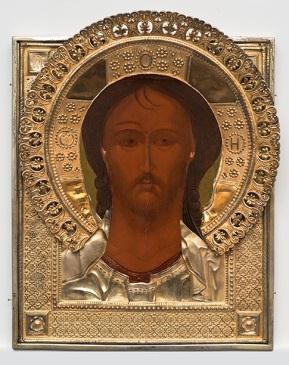
Unknown
Russian
Jesus Christ, 1837 ca.
egg tempera on wood (silver revetment by Fedor Verkhovtsev, 1804-1867)
13 1/2 x 11 3/8 in.
SBMA, Anonymous Gift
1961.5.8a,b
COMMENTS
Description
Christ in bust form is shown looking with penetrating glance at the observer. A richly decorated gilded silver oklad was added in the 19th century and duplicates part of the painting on the panel underneath. The halo extends beyond the icon frame in a finely worked Baroque floral decoration. Within the cross of the halo are rosette patterns which also appear in the oklad’s border.
Origin and Iconography
This type of image, known as “The Savior with the Angry Eye,” stems from earlier versions of the Pantocrator, or Christ Omnipotent, which portrayed Christ’s mien as severe and almost threatening. Beginning about the 9th century, the image often appeared in Byzantine art. Perhaps the most impressive of the Byzantine examples is the dome mosaic in the 11th century monastic church at Daphni near Athens. The earliest example in Russia is a 14th century icon in Uspensky Cathedral of the Moscow Kremlin. As usual, the cruciform halo of Christ contains letters OWH, a reference to His Eternal Nature. In the upper corners of the riza are the abbreviations of Jesus Christ, NC XC.
Style
This version of “The Savior with the Angry Eye” reflects an amelioration of the stern, penetrating gaze of earlier representations. The influence of Andrei Rublëv is clearly evident in the use of a small mouth, soft beard and moustache, long, narrow nose, and stylized eyes with enliveners (white highlights) around the pupils and over the shallow, curved eyebrows. The hair forms a kind of ogive arch (kokoshnik in Russian) over the face and falls to the sides in rhythmical curves and spirals. The dark complexion of the face is a result of darkening of the olipha which was applied to protect the painting.
The sumptuous oklad, while a masterpiece of metalwork in its own right, tends to overwhelm the painted impression of Christ’s face.
- Robert Henning, Jr., "Russian Icons in Santa Barbara," Santa Barbara Museum of Art, 1982
Bibliography
E.M. Jones, “The Pantokrator. A Study of the Iconography,” Eastern Churches Quarterly, 9, -1952, pp. 266-72.
Bohs Rothemund, Handbuch de Ikonenkunst, Munich, 1966, p. 208.
A. Voyce, The Art and Architecture of Medieval Russia, Oklahoma, 1967, pp. 327 & 348.
G. Zidkov, “L’icone du ‘Saveur à l’oeil courroucé à Moscou, ”L’art byzantine chez les slaves, vol.5, Paris, 1931, p. 174f.
SBMA CURATORIAL LABELS
Even though this image is painted in a conservative style, it is most likely contemporary with its metal cover, stamped with manufacturer's marks from 1837. Such covers protected the icon, which could be touched and kissed as a sign of veneration. The distance between viewer and image is shortened through a "close-up" than reduces Christ's portrait to His face and shoulders. The labelling Slavonic inscription reads: "Jesus Christ, Ruler of All".
- Religious Images of the Christian East, 2013
